June Feature Interview
Roads Less Traveled
Three GB&I Regional Tours by Angela Moser,
Robin Hiseman and Clyde Johnson
Additional insight provided by Jeff Warne and Robin Down
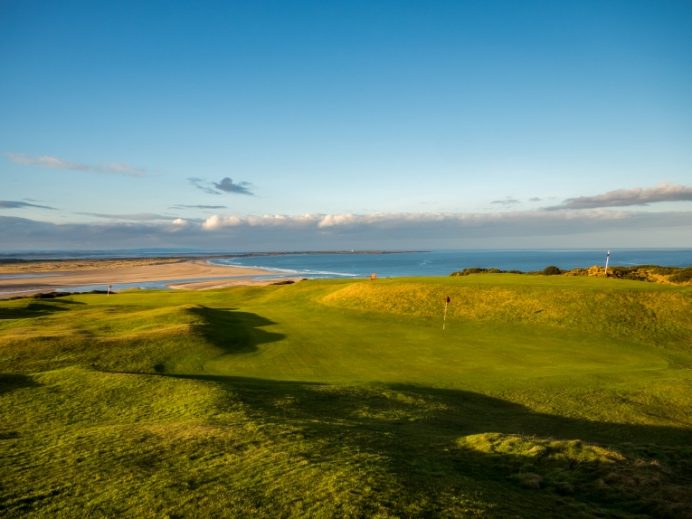
As much as any sport, golf offers huge rewards to those willing to explore the roads less traveled. Photo courtesy of Clyde Johnson of holes 14 and 5 at Bamburgh Castle in England.
 |
Donegal, Ireland by Angela Moser (7 courses separated by 156 miles) |
Preface by Jeff Warne
You’ve played a few Open Rota courses in England and Scotland, made the pilgrimage to St. Andrews and you’ve done the Southwest of Ireland-complete with the obligatory kissing of the Blarney Stone, the Cliffs of Moher, the Ring of Kerry and the tourist/Guiness laden pubs of Killarney. Now you’re ready for the “real” Ireland, located in Donegal, in the remote northwest corner of Ireland.
Why Donegal? Why make the effort when the nearest airport without a connection from the US is in Dublin, 3-4 hours away on winding, often scarily narrow roads? Quite simply, Donegal with its otherworldly, varied and often wild scenery, authentic Gaelic speaking pubs, woolen mills and delightful array of links golf as to be found anywhere, is simply the most unspoiled place one can travel to combine all of the above, at a mere fraction of the price to be found elsewhere.
But hurry, that could change with the June 2021 opening of the new Tom Doak designed St. Patrick’s Links at Rosapenna, adding another first tier course to what is already one of the best array of hidden gems to be had in any one region of the UK/Ireland.
The ideal way to see Donegal is to start at the aptly named “Donegal Town”(3 hours from Dublin) and work one’s way around on the Atlantic Drive (www.irelandnorthwest.ie/pThe-Donegal-Atlantic-Drive.html) ending up on the Inishowen Peninsula-or-doing the journey in reverse, stopping and staying in a few of the charming towns and villages along the way. Dunfanaghy and Buncrana are two of my favorites, the former hosting one of the best live music festivals in all of Ireland (www.dunfanaghy.info/festivals).
Past Donegal Town, the Atlantic Drive takes one to such spectacular sights as the Slieve League Cliffs, which dwarf the more famous and widely visited Cliffs of Moher, and winds its way around the coast for hundreds of kilometers, passing through numerous scenic landmarks and charming “frozen in time” small towns and pubs, leading to some of the most unheralded spectacular links courses in the world.
Though the golf is eclectic and special, it is the scenery, sights, craic/music, people and experiences that will keep you coming back. Having traveled to Donegal more than 10 times since my initial visit in 1997, each time I return, I realize how I’d like to continually add to that total – as soon as possible! JW
Suggested detours:
Slieve League Cliffs -near Narin and Portnoo
Horn Head on Atlantic Drive near Dunfanaghy
The DRIVE to Cruit Island
Atlantic Drive near Downings/Rosapenna – long route to the Singing Pub
Rosapenna to Portsalon via Mulroy Bridge
Jazz festival in Dunfanaghy-great time, runs annually in September
Nairn & Portnoo, Portnoo.
Redesigned by Gil Hanse with Jim Wagner, 2020.
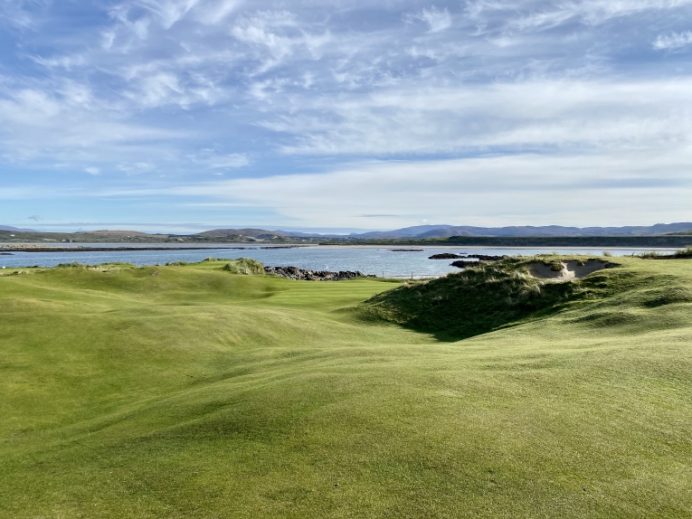
The approach to the 7th at Narin & Portnoo. Photo courtesy of Angela Moser.
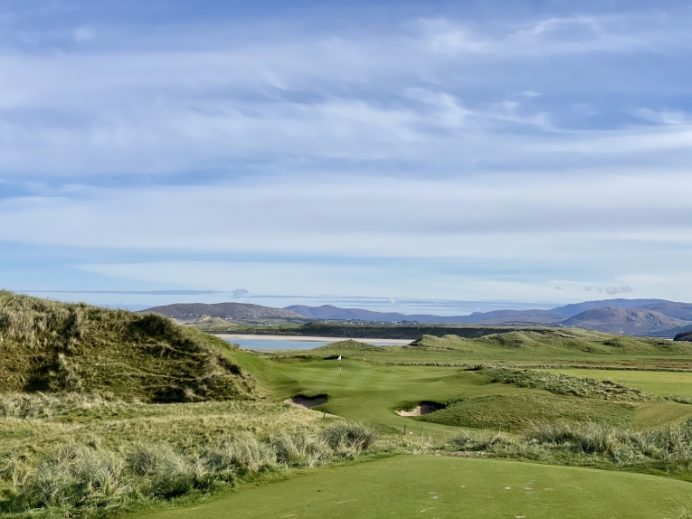
The newly created 11th green at Narin & Portnoo. Photo courtesy of Angela Moser.
After numerous and expensive alterations to make the course play longer in 2004, a new investor bought the club to bring in world-renown architect Gil Hanse to redesign the links over the past three winters. The course starts over relatively flat inland terrain, playing outwards to the tip of a magnificent dune system. The humps and bumps, peaks and craters are beautifully used from what is now the 4th hole, a doglegged par-4 with some undulations in the fairway to layup or diagonally hit over to an uphill green. The short par-4 7th still plays out to the point with breathtaking views over Dooey Beach and its massive sand blow-out halfpipe. The green is squeezed in behind a mound in the front and the ocean in the back. Depending on how much you flirt with the fairway’s left side and the possibility to end up in the marram, you will get a better angle into the green. The par-4 8th plays blind off the tee into a dropped down fairway with cool mounding and the green sitting at the edge of the cliff. The new par-3 11th is a short little devil in the highest ground of the dunes with one last view over a dune tip. Here you turn and play back towards the clubhouse, crossing several times over the dune system to play inland and back onto the highest ground of the dunes with beautiful views over Portnoo Beach. Hanse and the cavemen turned up the volume of the bunkers by placing them strategically on the holes and choosing a very natural edge look that fits visually to the course.
As Nairn & Portnoo is one of the remote outposts of Irish links golf; the dining experience runs relatively scarce. The clubhouse restaurant ‘Michaelangelos’ is excellent, but the ‘not to be missed’ recommendation is the fun and quirky experience at Sandfield Pitch & Putt. AM

Don’t miss the pitch and putt at Sandfield. Photo courtesy of Angela Moser.
Cruit Island, Kincasslagh.
Michael Doherty, 1986.
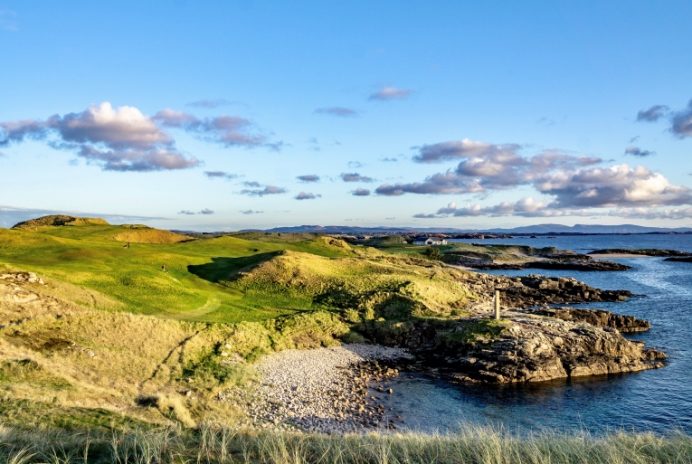
The spectacular 7th at Cruit Island. Photo courtesy of Angela Moser.
The golf course is situated at the far end of Cruit Island with 270° degree views over the Atlantic Ocean, the rough cliff edges, beautiful sand beaches and scattered islands. Cruit feels like you discovered the most beautiful and stunning world’s end.
Although of its relative youth, Cruit has the feel of an old quirky links that has always been there. The nine-hole golf course is unique, an absolute hidden gem and cannot be missed when traveling through County Donegal. The charm starts with the need to honk your car when driving in as the first hole crosses the road. While the views are stunning, the golf doesn’t lack either. The variety of shots is incredible since the course is routed in every direction, with the Atlantic gusts playing a significant role in your club and shot selection. The higher ground in the middle of the property is of great use to tee off from numerous times to play towards the ocean, but also when playing back on its ridges and depressions. With greens sitting at the point, tucked into the side of a hill, a punchbowl, or situated on the crest of a ridge – this course doesn’t get boring and is, with its tiny bunkers, well protected. There are many excellent holes out there, with the par-3 6th being the most photographed, followed by the uphill par-4 7th to a half-blind green that is slightly falling away.
The Caisleain Oir Hotel will be your best stay and dinner spot, with the locals’ favorite Seafood Chowder. AM
St. Patrick’s Links, Carrigart.
Tom Doak with Eric Iverson, 2021.
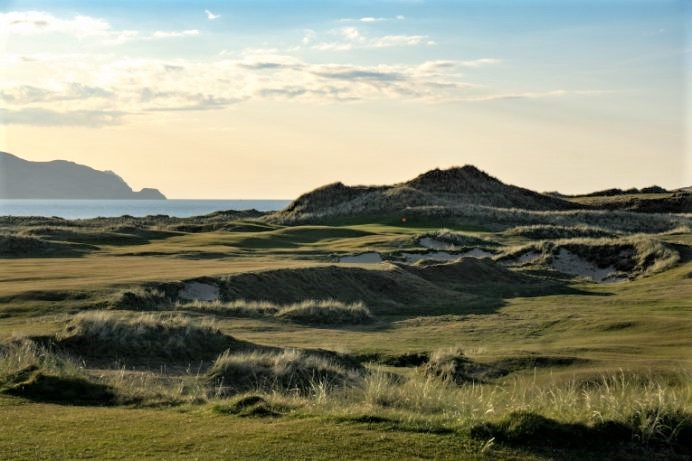
Looking down the 8th at St. Patrick’s …
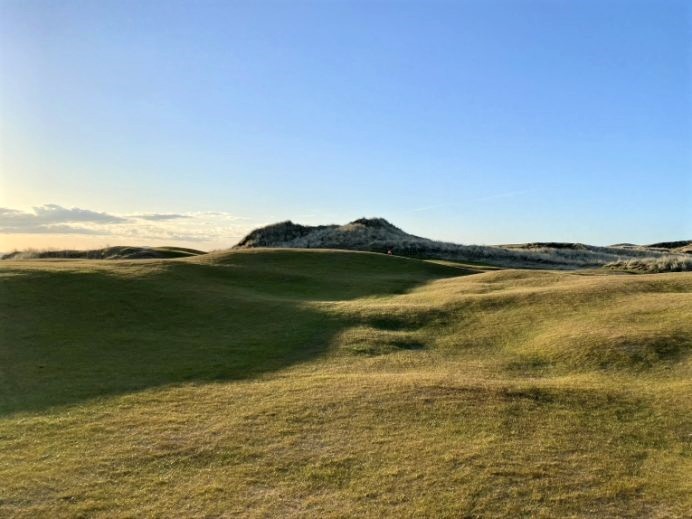
… with this bump needing to be overcome on one’s approach. Both photos courtesy of Angela Moser.
Situated with views over Sheephaven Bay, Horn Head and the Donegal mountain range, the new 18-hole golf course is routed tremendously well through the dunes. With an inland start, you will be playing your way towards the ocean and back towards the clubhouse. But don’t be mistaken, thinking the inland holes are less dramatic, as they play through the biggest sand blow-outs of the area. The second nine start inland as well and play their way around, crescendoing to the top of the hill Maheramagorgan with breathtaking views from the 16th tee over the whole area and Downings Bay. Make sure you give your camera or phone a full battery charge before you get to the course.
Multiple holes include playing over rumpling fairways with some deep pockets or sand blow-outs that you should rather avoid. The 4th and 6th holes share a diagonal natural sand scar that will make you choose your club wisely off the tees, as well as on the second shots. From entirely visable, half, to fully blind, the variety of greens depend primarily on where you place your tee shot. A good example is the short par-4 8th with a mound in front of the green that will make you choose one side of the fairway to approach or even see the small green.
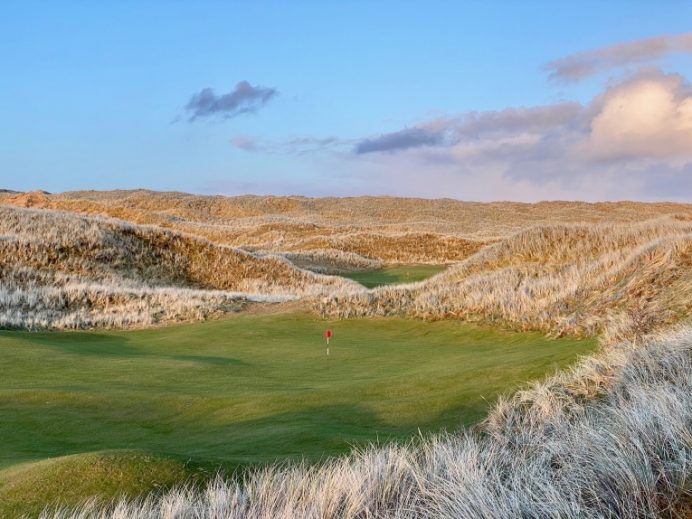
The 1st and 7th greens. Photo courtesy of Angela Moser.
For the best deal, you want to book a package with the Rosapenna Hotel & Golf Resort, which offers lots of high quality golf options. In fact, the Old Tom Morris course is a personal favorite of Paul McGinley’s and is one of the hosts for the Irish Legends. The summer evenings are best spent between the nationally awarded Fisk seafood restaurant, located adjacent to the Harbour Bar or the Goose & Gander Pizzeria & Cocktail Bar. AM
Portsalon Golf Club, Portsalon.
From 1891, Pat Ruddy 2000.
Commentary by Jeff Warne
Going in, one of my favorite courses in the world and still is. Great friendly welcome in both the clubhouse and the bar – in short, no better place on earth.
The first hole climbs to an incredibly quirky green, setting the stage for…the spectacular second hole, downhill over and around an estuary which forms a wonderful cape, before turning into a burn in front of the green to punish those who played too conservatively off the tee. The next few holes play along the ocean and while a bit of valley golf, are varied enough (and each great by itself) to separate themselves. Many turns and twists abound and later in the round, after playing along the spectacular beach, the course turns up into the very edges of the non-links land, beneath the mountains. High enough to see out over the spectacular links, beach and town while in a microclimate. Have to see it to appreciate it but holes 13-17 own an enchanting piece of land between the mountain and the links where tees are positioned to play back out onto the links while overlooking the whole scene. Number 17 is a great par 5 looking out to the ocean and playing around a stream, again with links land bordering the adjacent farmland. In heavy wind play the ground game as but only a couple of holes require aerial shots.
One could easily stay in Portsalon for a week and commute outward for the odd round. Eat lunch at Sarah’s (a favorite haunt along with The Stores pub next door) just beyond the clubhouse on the water. JW
North West GC, Lisfannan.
Current changes by Eddie Hackett and Pat Ruddy.
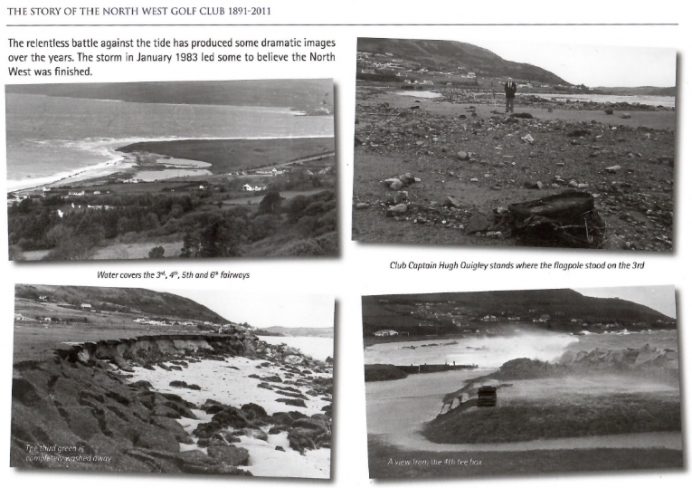
As one of the founding members of the GUI, North West is one of Ireland’s oldest golf courses. Charles Thompson, a pro from Royal Portrush, who also laid out the course at Portsalon, designed nine holes at the shore of Lough Swilly in 1891. It has seen a lot of changes, which fall partially to coastal erosion in 1968 and 1983. With only 30ha (75acres) property left, the 18-hole course has its limitations and is tight. If you can overlook this weakness, you will find a dazzling links course. It has character, is fun, charming and old-fashioned.
The course starts at the beach, playing 11 holes counterclockwise on the boundary, with the finishing holes inside the broadest part of the property. While the land looks primarily flat, surprisingly remarkable landforms add to the flavor of the course. There are still original fairways and greens from 1891, and they are entertaining to play. The par-3 16th is one of them and probably referred to the most. It can only be described as a cute but wicked hole. ‘Fairy’ measures 93 yards from the back tee with extensive bunkering and an undulated green that falls away towards a creek. The two par-4s’ Inch’ and ‘Witches’ add tremendously to the links flavor, as they are fantastic two-shotters with undulated (!) fairways and challenging greens. There are still some hints and footprints of the old outstanding bunkering. One great example is the pockets of sand between the 7th and 12th green, which used to divide the holes beautifully and stopped long shots from running onto the other green.
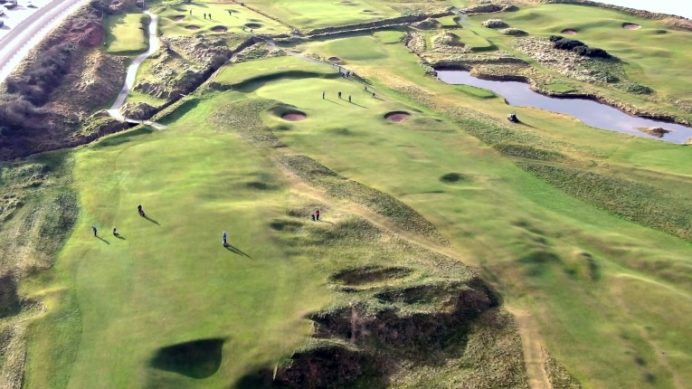
7th on left, 15 playing up, 16 is the short par3, 17 tee below the lake, 4th green above lake. Photo courtesy of North West GC.
Between the fancy The Red Door restaurant in Fahan and the rustic, charming The Drift Inn in Buncrana, you will get fantastic food. A good addition to the trip is Wild Ireland, a zoo in Fahan. AM
Ballyliffin GC (Old Links), Ballyliffin.
From 1947, Eddie Hackett 1973, Nick Faldo 2006.
commentary by Jeff Warne
Located on the tip of the Inishowen Peninsula, Ballyliffin is the northernmost course in Ireland with views of Pollan Strand beach and Glashedy Rock. The Old Links (‘old’ is a relative term here as the course dates back only to 1973) is a traditional links course with many rolls, pitches and unlevel lies. The sense of place is one of a more modern take versus that of oldish quirk/distinction. The most memorable hole on the front nine is the par-3 5th, ‘The Tank’ with its elevated tee and its green perched 179 yards away. Some great views are to be had as well as some really good closing holes with great variety and memorability. The spectacular par-5 14th,
‘Bulbin’ along the shore and the doglegging par-4 15th, ‘Ardacanlan’, playing downhill at 480 yards are of special note
Certainly a very good two course destination when combined with its newer, sister course Glashedy Links which opened in 1995. Eat lunch and/or dinner at the club as the people everywhere are polite and will be quite happy to see you. JW
Greencastle GC, Greencastle.
1892.
A quaint, perfectly situated clubhouse with a pint and lunch – a great way to start your trip after an overnight flight.
First hole a bit contrived 90-degree dogleg driveable by playing over a 100% blind large heather covered hill. The second rises to high ground revealing views out over the property and water. Greencastle’s front nine feels mainly inland but has a number of good holes and still includes the expansive views across the water and property. The par-3 5th hole sits on a rocky peninsula amidst spectacular scenery that Pebble Beach would be proud to have in its arsenal.
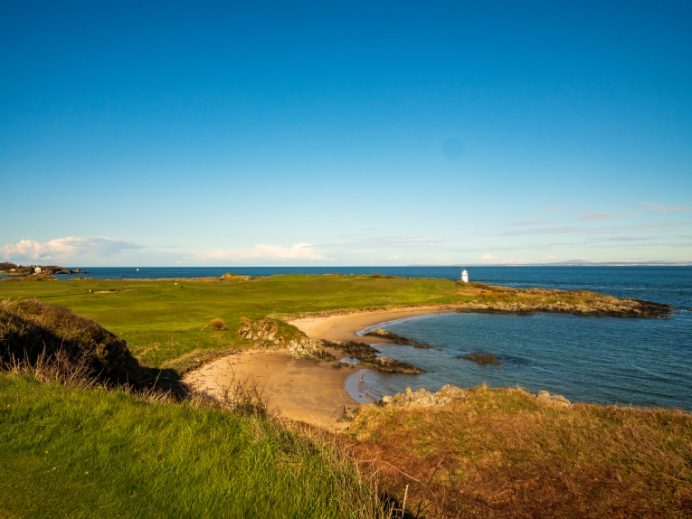
The 12th at Greencastle features a a dramatic drive over Lough Foyle and an approach to a blind green that nestles on the water beneath the lighthouse. Photo courtesy of Clyde Johnson.
The back nine is closer to water and linksier in feel with the highlight being the simply stunning 12th hole – a dogleg right along the water with a lighthouse in background and a sunken green located behind a heathery rise in the fairway. There are quite a few good holes on the back including the linksy 11th benched against a giant dune that the 12th tee sat atop as well as a well- sited tee on the 13th, the good returning 14th and the 16th. Number 17 is a bit average, a safety-tree infested par 4, but the home hole is a decent elevated tee par-3 back to the clubhouse
Greencastle is definitely time well spent, especially on a sunny breezy day. A few of the views look more like Casa de Campo than Donegal with palm trees and rocky cliff backgrounds. The true closest comparison would be Ardglass. JW
 |
Scotland’s Grampian Coast by Robin Hiseman (7 courses separated by 77 miles) |
Preface by Robin Down
From Findhorn to Fraserburgh, this north facing coast is defined by fishing villages, the remnants of conflict and a string of magnificent golf courses. It is the sea that dominates – throughout the 18th and 19th centuries it was the primary source of a life and a living for the villages scattered along its shores.
Scottish fishing boats were small-sailed vessels with open hulls and a shallow design to allow them to be launched from beaches. In the great storm of 1848, 124 of these fragile boats were lost and 100 fishermen drowned. It was this tragedy that prompted the building and improvement of the many small harbours that pepper the Moray and Aberdeenshire coasts.
Travel a short distance inland and there are disused railways, abandoned airfields, pillboxes, gun houses and anti-invasion cubes. History has made its mark on this landscape but, as time passes, nature is slowly hiding the evidence.
Except for RAF Lossiemouth, the military has moved out, the steam trains no longer ply the country lines and the fishing industry has turned large-scale and industrial, leaving fishing villages as the preserve of tourists. At first glance, golf appears to have survived unscathed but, at the end of the of the 19th century and the height of golf mania, there were many more courses along this northern shore – Findhorn, Forres, Burghead & Duffus, Buckie, Portsoy, Banff, Rosehearty, Inverallochy. Many closed during the World Wars and did not re-open. We must be grateful for what remains.
Follow the A98 from Cullen to Fraserburgh and the best of these northern shores will be missed. Instead, divert along ‘B’ roads, take the road less travelled and meander from one coastal gem to another – Portsoy, Whitehills, Macduff, Gardenstown, Crovie and, the best of them, Pennan. A row of solid fisherman’s cottages stretches along the village’s single street, squeezed between the cliffs and sea with a small harbour to the east. Pennan was made famous in the 1980s as one of the prime locations for the film Local Hero starring Burt Lancaster. The red telephone box that featured regularly in the film remains in location and attracts a regular stream of visitors even though the original was a prop. RD
Covesea Links, Duffus.
2010.
Commentary by Robin Down
Drive through Lossiemouth and the presence of golfing terrain is obvious. By contrast, Covesea, accessed by an unmade track, could be too easily missed. Make the effort and find it because this place is special.
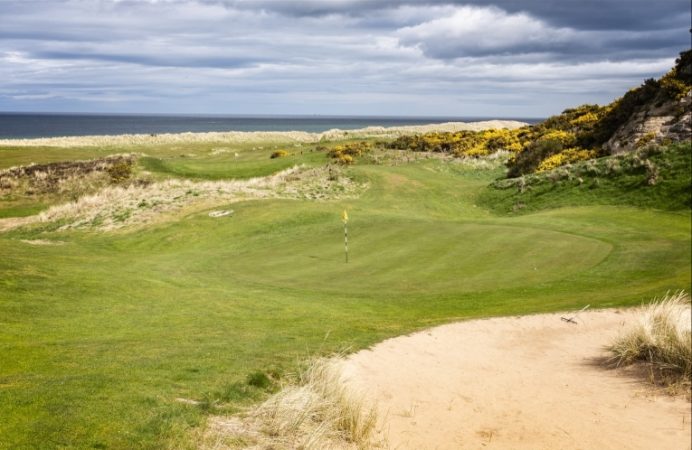
In the foreground is Covesea’s 8th green and beyond is its vexing 9th. Photo courtesy of Robin Down.
Unusually, Covesea is not a members’ club, so the course is entirely the domain of the owner, Andy Burnett. It thereby avoids the plague of the grumpy golfer who will seek to blame all his misfortune on anything but his inadequate game. Consequently, the usual rules, regulations and members’ priority are entirely missing. “We’ve always run the place without any airs and graces – everyone is welcome to come and play”. It is an attractive operational model.
Andy is an accomplished greenkeeper and, it shows – well tended fairways, beautiful greens, this is links golf as the gods intended. The first four holes track back and forth, parallel with the immediately adjacent Moray coast with an 1846 lighthouse providing a majestic backdrop. However, it is at the fifth where the genius of Covesea begins to reveal itself. A blind uphill par 3, a short iron must deliver the ball 33 feet above to a narrow banana-shaped green sitting at the high-point of the course. The par-3 sixth plays from a wildly elevated tee, the seventh plays blind over an enormous rock, the eighth plays blind between rocks and the ninth plays from under the rocks to a small green shaped like an upside-down mortar dish. Make no mistake, this is as difficult and entertaining as golf gets and it is all achieved within the kind of acreage that some parkland courses would struggle to accommodate a couple of holes. Like I say, make the effort and find it. RD
Moray GC (Old), Lossiemouth.
Old Tom Morris, 1889.
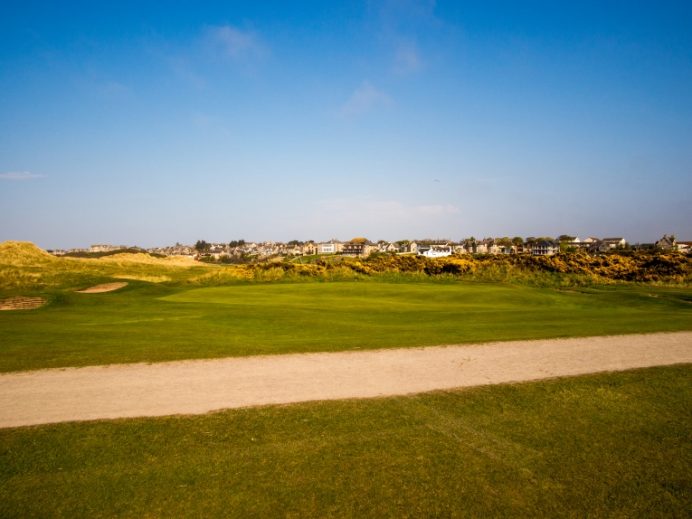
The 16th is but one fine green complex out of many at Moray Old. Photo courtesy of Clyde Johnson.
A charming characteristic of the first generation of Scottish golf links is how the courses start and finish almost on the high street. Think of St. Andrews and North Berwick. To complete this triumvirate there is Moray (pronounced Murry), which replicates the hole arrangement, but with better, more dramatic dune terrain. The Moray Golf Club belongs to the town of Lossiemouth, which juts defiantly into the southern Moray Firth on a sandstone headland, with one of Britain’s best beaches to the east and 36-holes of quality links golf to the west. Once an important fishing town, Lossiemouth is now almost entirely dependent on the adjacent RAF Lossiemouth for trade. It’s a busy base and more often than not, golf at Moray is accompanied by the air-splitting soundtrack of screaming Typhoon Eurofighters taking off and landing. Moray Old is a tough, championship-proven, thoroughbred links, set out on mostly flat ground and heavily defined by banks of gorse and heather, with a liberal sprinkling of traditional revetted bunkers. It opens out on the back nine as it nears the beach and the final run for home is particularly fine, climaxing with arguably the best 18th hole in all of Scottish golf. RH
Spey Bay GC, Spey Bay.
Ben Sayer, 1907.

A punchbowl green sits beyond the ripple of micro contours that characterize Spey Bay. Buckie is in the background, where Buckpool and Strathlene Golf Clubs can be found at either end of the town. Photo courtesy of Clyde Johnson.
The Spey is one of Scotland’s great rivers, famed for salmon fishing and whisky. It spills into the North Sea at Spey Bay, surging through a spectacular pebble ridge. You may well spot the occasional Dolphin out to sea, which often outnumber visiting golfers to this, one of Scotland’s least known links. When it was laid out by Ben Sayers in the early years of the 20th Century, Spey Bay was a desirable seaside resort, with a plush hotel and a railway station. It eventually lost the rail connection and the hotel burnt down, leaving this lonely, disembodied, but charming course. What differentiates it from other links is that it is laid out along raised longitudinal ridges of storm-tossed pebbled and boulders, rather than sand. The fairways often follow the half-pipe vales between the ridges and the entire course is an object lesson in micro-contouring. It is brutally exposed to the fearsome storms of the Moray Firth and has lost several holes to the surf, with one or two more set to disappear soon. The skeleton green staff battle to keep the gorse at bay and the course in good condition and it has always felt on the verge of closure. It’s well worth a game, so get there before, like so many Speyside salmon, it becomes the one that got away. RH
Cullen GC, Cullen.
From 1870.
Golf in Cullen is all about fun. Here is a veritable fairground of unique holes and shots the likes of which you have never experienced before, all set within a landscape that is as much a geology lesson as it is a golf course. This tiny, 4600-yard, 18-hole course, with ten par 3’s plays along clifftops and a raised beach curving around a gorgeous cove. Dominating the landscape are a cluster of colossal Old Red Sandstone sea stacks. For countless years these were battered by ocean waves, but since the last ice age have been uplifted above the shore line. You get to play over and around them on consecutive blind par 3’s for which words cannot do justice.
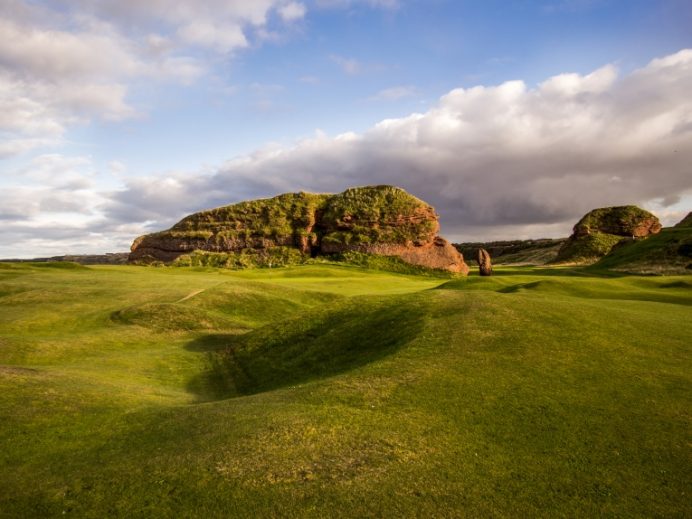
Cullen is chock full of unique and interesting landforms. Photo courtesy of Clyde Johnson.
Cullen is a course that will make you glad to be alive and which is perfectly suited to playing with a half set slung over your shoulder and a carefree attitude. If you’re lucky enough to play it late on a sunny summer’s day, you’ll witness the vivid red rocks ablaze with color. Make time to try out the local delicacy of Cullen Skink, a delicious haddock and potato broth that the charming fishing village is rightly famous for. RH
Duff House Royal GC, Banff.
From 1910, redesigned by Alister MacKenzie 1923.
The only ‘Royal’ golf club in the world to use its prestigious title as a suffix, Duff House is the golf course that architecture aficionados need to see. Here is an original and well-preserved Alister Mackenzie design, notable for the huge and typically adventurous greens, which look pretty much exactly as Alister left them a century ago. They alone are worth the diversion to the seaside town of Banff, where this flat, easy walking parkland course sits alongside the pretty River Deveron, close to its outlet into the North Sea.

The shared 1st (white flag) and 17th (red flag) green sits beneath the arched bridge which connects Banff with Macduff. *There’s a fierce backstory between the two towns! Photo courtesy of Clyde Johnson.
The course winds through the tall trees of the mature, designed parkland of the imposing 18th Century Duff House. A pair of immense double greens are an unusual feature, which Mackenzie has fitted out with extravagant internal contouring. Despite its venerable title, this is a homely and comfortable locals golf club, which delights in welcoming those visitors who have taken the effort to detour away from the well-trodden tourist trail. However, don’t expect any mercy with their caustic appraisal of opening tee shots, played from directly in front of the bar’s broad picture windows. Not good for those with stage fright. RH
Rosehearty GC, Rosehearty.
1971.
(commentary by Clyde Johnson)
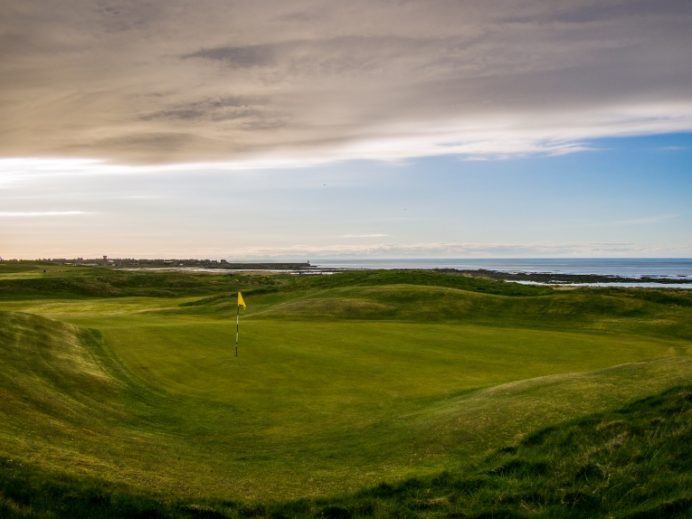
A shot from behind of the short par-4 4th at Rosehearty with its green tucked beyond a dune. Photo courtesy of Clyde Johnson.
At a mere 2214 yards, there is not much to see here – apart from some (if the weather behaves) glassy sea views – or so you would think!? The short first, its green angled between a catcher’s mit of dunes, and the fortified drop shot sixth are the highlights of five well varied threes. Play close to the coastal road to open up a distant view of the stern third, while your approach to the fifth will hope to hold the precipice hugging green. All that, if you’ve made it out of The Masons Arms – the pub that you’ve paid your 8-quid green fee. CJ
Fraserburgh GC, Fraserburgh.
From 1891, redesigned by James Braid, 1922.

The opening and closing holes at Fraserburgh do little to convey the exquisite micro contours found on the opposite side of the hill from the clubhouse.
It takes dedication to get to Fraserburgh. Located at the very northern tip of Grampian, where the coastline makes a sudden left turn and heads towards Inverness, this stoic fishing port is not generally on the radar of those seeking classic links golf. That would be a mistake. This exposed coastline is battered by ferocious North Sea storms, which have helped fashion a stretch of turbulent linksland home to Scotland’s least heralded great links course. Don’t be fooled by modest first impressions of conjoined opening and closing holes as flat as a football field, because Fraserburgh quickly gets up to pace with a sequence of sporty, James Braid designed holes circumnavigating the summit of Corbie Hill, from where enticing views of the links holes below promise thrills aplenty. The great holes are found on the back nine, with special mention to the short par 4 13th, where giant moguls block off the direct line into a punchbowl green featuring a closely mown backstop as steep as a velodrome. The following run of four holes, heading back north along a narrow valley behind the primary dune ridge, is in dramatic contrast to those played earlier. A very worthwhile inclusion on any itinerary. RH
 |
Northumberland Coast, England by Clyde Johnson (5 courses separated by 43 miles) |
The walled border town of Berwick-upon-Tweed last changed hands in 1482. Venturing south along England’s forgotten seaboard brings one of the United Kingdom’s most idyllic eighteens, and a handful of almost as beautiful places to enjoy the game.
Northumberland was ‘the land of the people living north of the Humber’ River. In the mind, today’s county boundary starts north of Newcastle-upon-Tyne – the capital of the North East, famed amongst the younger demographic for it’s raucous and loosely morale-d nights out. A contrast to the land once seen as the ‘Cradle of Christianity.’ Holy Island is a worthwhile pilgrimage, even if James Braid’s nine holes have long laid beneath the marram…just don’t forget to check the tide times! This is a coastline of castles, though the golf will take you to most of those. Golden and relatively desolate beaches too. There are fine formal gardens, and Kielder Forest if you stray far enough inland. Though the smokies at Seahouses were a favourite of my Dad, you’d find me refueling at a quiet country pub.
Heading from Brancaster towards the West Links at North Berwick, comes Seacroft and Seaton Carew, and then this short stretch of much more. CJ
Goswick GC, Goswick.
From 1890, updated by James Braid, 1930.

Goswick’s isolated setting bewitches. Photo courtesy of Clyde Johnson.
Berwick-upon-Tweed Golf Club. Not to be confused with Magdelene Fields, a plainer layout sandwiched between the border town’s Elizabethan walls and the North Sea. A little to the south, and just beyond the east coast mainline, Goswick Links lie inconspicuous. That’s not the only thing hiding, with countless explosive devices buried in the fore dunes, a relic of World War II rookie bombers. Perhaps that’s what left the crater in front of the short second green!? *
An awkward four, dog-legging around the drivable finisher, has stepped onto the dominant dune ridge. After that treacherous, once sand-faced hop, the third sweeps back off it. There’s a good variety to these early green complexes with that of the long fourth squeezed tight by opposing humps and bumps. An inelegant gouge defends the inside line, as the golf slides back onto the side of the dunes,. Reverting again, the most northerly 100 yards or so of the par-5 sixth becomes especially rollicking. It has been a stern stretch, though surely there must be more golf in those dunes beyond!?
There is an inevitably stark contrast when you’re back amongst the flat. Not a lack of invention though, with the seventh green benched snuggly onto the base of an embankment, its entrance choked by a string of angling pots. On a southward march, the contour ripples up once the clubhouse has been passed. Really so, where the tempting twelfth is teasingly interrupted by the tapering of the dune ridge. There’s a timeless romanticism to the distant outlook as you crest this broken ground. An even greater isolation as a fine four chases up the backside of the dune into a half-pipe.
Finally atop of the ridge, a moment must be taken to admire the expanse of marram and beyond. Facing greener pastures though, the sixteenth drops into a well-protected 3-sided bath tub. There’s not many of those shots to be found by the sea! Unconventional in a different way, a graveled footpath lies tight to the front of the par-5 seventeenth. Having dealt with the final throng of pots, reflections will place Goswick as challenging links with more than enough unorthodoxy to entertain. CJ
*(It wasn’t.)
Bamburgh Castle GC, Bamburgh.
George Rochester, 1904.
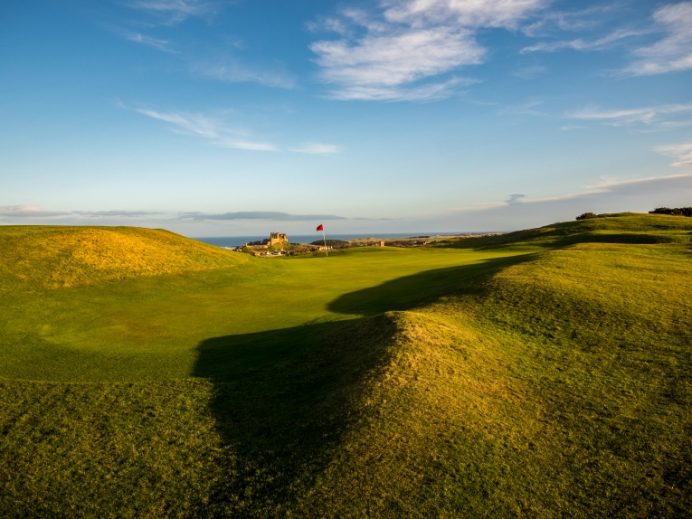
No secret the derivation of Bamburgh Castle’s name! Photo courtesy of Clyde Johnson.
Perched proudly on its’ dolerite outcrop, Bamburgh Castle dominates the scene like no other. With fifth century origins as a fort, today’s imperious iteration can loosely be traced via a millennium of evolution. High, to the north, though sneakily accessed down a quaint side street, the village’s golf club dates to a more comprehensible 1904.
A pair of cliff-edge chasing threes lead to back-to-back fives. You soon know you are in for something a little different! Early history, as so often is the case, was key. The stone quarry, which dominates the characterful tract, was discontinued during the first war, and so the adventure could really begin. You’ll pass it as soon as the third, and follow remnants of an old pier -connecting rail track as you wrap around Budle Bay. Though you have swung inland, the fourth greens distant green backdrop is no less impressive.
Blind drives, rocky escarpments and obscured greens follow. If you can avoid the optical distractions, dramatic, though not overly strenuous, elevation change will test all shots. It is a long-three and short-four that ascend to the high-point, and from there you’ll jump from crag-to-crag! Not the most conventionally shaped parcel(s) of land, the early golfers of Bamburgh clearly sort adventure first. As play loops into a southerly outpost, the canvas is rig-and-furrow, interrupted by speckles of gorse and a protruding core. The transition back to the peak is also made in one, semi-blind stroke – trust the shallow saddle, with the knowledge of compensatory outlooks left and right for any nervous failure.
The fine downhill fifteenth is at first exploratory, opening out to reveal a gulley hop, from a downhill stance, towards distant Holy Island and its Lindisfarne Castle! Turning away, a gash in the back-slope of the quarry, funnels on the angle; the sixteenth is within range, but only for the prickle-risking foolish. A castle wasn’t out of sight for long, but don’t use the main attraction as your aiming point at the drivable but dangerous penultimate.
Thrill-a-minute, there is more to this memorable course than its mesmerising three-hundred-and-sixty degree view! CJ
Dunstanburgh Castle GC, Embleton.
From 1900, redesigned by James Braid, 1922.
It’s a picturesque walk from the little fishing village of Craster towards the castle ruins. But, a more onerous perspective as the backdrop to the short thirteenth.
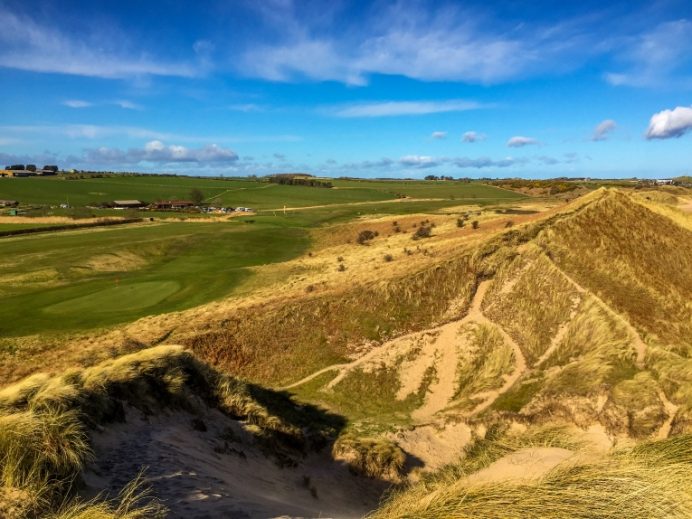
The 7th at Dunstanburgh Castle with its none too big green an elusive target in the wind. Photo courtesy of Clyde Johnson.
The golf course sits around the corner, on the inside of Embleton Bay, and its singular arête of dunes. Forgettable to begin, the blind second drive takes play onto a triangle of higher, agricultural holes, where the pronounced, slightly angled target of the one-shot fourth is a lone note. Leaving the diminutive ground behind, the sixth temptingly wraps to the left, its green leaning back to the right behind a hungry hollow. Plateaued and tucked behind a slight shoulder, the green after sits above an all together deeper depression. With the dunes still tight to the left, the landforms of the eighth place somewhere in the middle of the previous two’s scale. The dunes go away, but not that outlook. Not until the 14th turns away from that moated green at least. An outlook towards the sea has brought dulled terrain, but it is difficult to overly complain. Back-in, the boundary is a peripheral feature, but one exceeded by the bowled sixteenth green, and a final approach over a burn.
An especially quaint section of this coastline, with just enough holes of note to drag you out to play. CJ
Alnmouth Village GC, Alnmouth.
From 1869.
Thought to be England’s oldest 9-hole links, Alnmouth Village is tucked away at the base of the … well, village. Alnwick is the nearby town, and that has a castle too. A refined one, with excellent gardens.
Working north over gently rippling links-land, the outward journey tapers as cliffs squeeze towards the North Sea. The golf seems to build in quality, so much so that you’ll be disappointed to find the semi-moated fifth green at lands end. With just nine holes, the only way back is up!
Leaning back, the rise requires a stern hit, though not too strong (and/or right)…Harry Colt’s ‘modern’ eighteen – Foxton – sits over the far boundary. An aggressive angle into the chute pays dividend, with the green-perched high on a plinth. If you’ve made the simply tiered putting surface in two, reward yourself with the fine views, while your playing companions scramble.
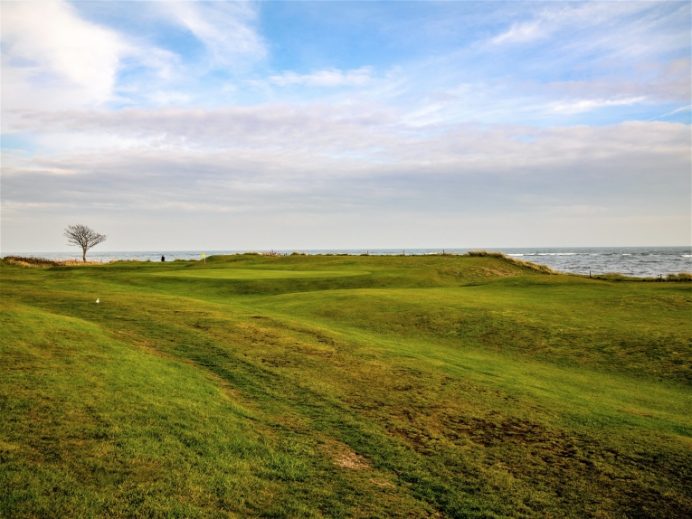
The 5th at Alnmouth Village with the North Sea conspicuously in view. Photo courtesy of Clyde Johnson.
Having parachuted immediately back onto the links, you’ll likely agree that the best golf was found over this brief encounter with heavier soils. Worth another go around, but if not, Warkworth’s nine hole links will suitably complement. CJ
Warkworth GC, Warkworth.
Old Tom Morris, 1891.

Warkworth joins Alnmouth Village as being another fine 9 holer in Northumberland. Photo courtesy of Clyde Johnson.
I wasn’t expecting to find such perky dunes on the Northumberland Coast. I was barely aware a golf course existed at Warkworth, but perhaps that’s because the medieval castle, a mile or so inland, claims all of the villages attention.
To start, there’s a long three that drops from high into a widening pocket beneath those high, triangles of dune. By contrast, it is a four to five feet high band of rumbles that is enough to obscure and unsettle the approach to the valley chasing second. The drive out angles up onto a half-piped shelf, running somewhere near two-thirds of the way back up to the bluff. Northwards along its edge, the terrain is devoid of the same drama, but compensated by fine seaward views. There’s a sense of living on the edge, as the fourth green finishes short of a deep v-shaped valley, which you then drive across. Pondering as you cross via a stilted wooden bridge, you’ll have already realised the best terrain and golf was fleeting. Three holes squeeze back south along the flat top, but the view from the clubhouse towards that fine opening stretch might enough for you to make it eighteen. CJ








